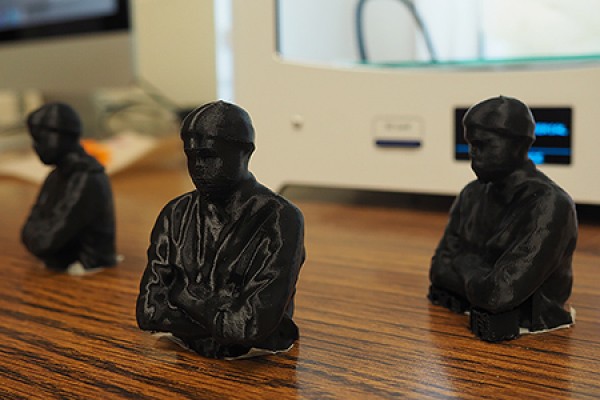 Busts of MFA student Luke Maddaford are the product of a three-dimensional printer in the School of Creative Arts.
Busts of MFA student Luke Maddaford are the product of a three-dimensional printer in the School of Creative Arts.
Newly acquired three-dimensional printers in professor Rod Strickland’s visual arts sculpture studio are opening creative possibilities for students in the UWindsor School of Creative Arts, as well as campus entrepreneurs.
These virtual tools replace such traditional tools as chisel and clay and come in the form of 3D scanning and printing technology, which allow students to create and build hard plastic artistic creations from digital files.
Funding for the scanners and printers came in part from the Entrepreneurship Practice and Innovation Centre (EPICentre). In addition to works of art, students will use the technology to help anyone on campus print unique entrepreneurial inventions and create 3D prototypes for design, sculpture and engineering.
“Students can now work in a more interdisciplinary fashion outside of the art school, with other people who have creative ideas, or entrepreneurial ideas, and don’t know how to realize these things,” says Strickland. “They can actually become both the artist, as well as the artist of the entrepreneurial creation.”
3D printers build objects through a process called additive manufacturing. From a digital file, the printer renders a solid, physical object using successive layers of liquid plastic that harden quickly.
The accurate and stable 3D models can be built with both a commercial grade plastic, as well as an organic-based plastic made from renewable resources. The models are not limited by the imagination, but are restricted by a footprint of 223 x 223 x 305 millimetres (8.5 x 8.5 x 12 inches). Strickland says larger objects can be built in modules and assembled after printing.
Students are trained on a software program called Rhinoceros, which they use to design original 3D images or manipulate images created by scanning objects with a 3D scanner. Digital sculpture is new to the curriculum this semester.
For his own research, Strickland is working with alumnus David Bobier (MFA 1984) of VibraFusionLab, and Ryerson University’s Inclusive Media Design Centre to design a mat from microphone parts that will ultimately help the hearing impaired enjoy live performances through sounds and vibrations.
“This is just the beginning stages of the designing elements that will be 3D printed, but I’ve come up with a grid that takes a sections of piezo based speakers, which transfer the audio vibrations,” he says. “We are working with technologies that will enhance deaf experience of sound performances, whether film or live performance, by creating a blanket, or mat, that slides behind a person, sitting in any chair so they can feel vibrations and be a part of the performance like never before.”
Ontario Centres of Excellence and Ontario Network of Entrepreneurs also provided funding for the 3D Print Lab.
Entrepreneurs interested in using the fee-for-service print facility located in room 133-A, LeBel Building, can visit 3D Print Lab, phone 519-253-3000, ext. 2910, or e-mail 3dprint@uwindsor.ca.
